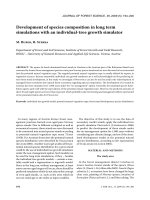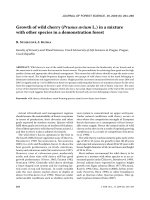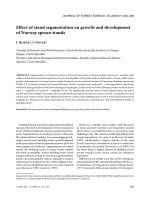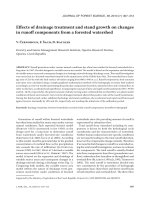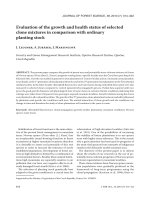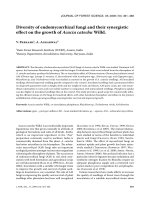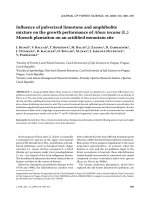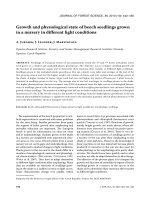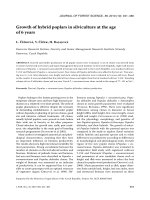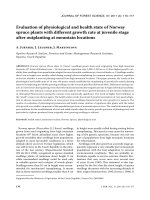Báo cáo lâm nghiệp: "Growth of hybrid poplars in silviculture at the age of 6 years" pps
Bạn đang xem bản rút gọn của tài liệu. Xem và tải ngay bản đầy đủ của tài liệu tại đây (229.52 KB, 10 trang )
J. FOR. SCI., 56, 2010 (10): 451–460 451
JOURNAL OF FOREST SCIENCE, 56, 2010 (10): 451–460
Supported by the Ministry of Agriculture of the Czech Republic, Project No. MZE 0002070203
Growth of hybrid poplars in silviculture at the age
of 6 years
L. Č, V. Č, H. B
Kunovice Research Station, Forestry and Game Management Research Institute Strnady,
Kunovice, Czech Republic
ABSTRACT: Growth and timber production of 28 poplar clones were evaluated. A set of clones was derived from
14 clones newly bred in Forestry and Game Management Research Institute in the Czech Republic, eight well-known
cultivars of Populus × euroamericana planted in Europe and imported to the Czech Republic, two standard cultivars
'I-214' and 'Robusta' (Populus × euroamericana). Four clones of Populus deltoides were added to the test set. Tree spac-
ing was 4 × 4 m. Stem diameter, tree height and stem volume production were evaluated in 6-years-old trees. Based
on the results, it was concluded that the yield of four clones was higher than that of standard cultivar 'I-214'. Standing
volume of two P. deltoides clones and one new Czech P. × euroamericana clone varied in the range of 77–121 m
3
·ha
–1
.
Keywords: Fluvisol; Populus × euroamericana; Populus deltoides; timber production
Poplars belong to the fastest growing trees in the
temperate climate zone and have high biomass pro-
duction in a relatively very short period. e yield of
poplar plantations is eff ective despite the necessity
of demanding establishment. A successful poplar
culture depends on planting of proven clones, good
site and intensive cultural treatments. All clones,
usually hybrid poplars, were proved in tests before
their wide use in forestry or for other purposes.
Clonal selection for growth rate, yield, pest resist-
ance, site adaptability is the main goal of breeding
research programmes (S et al. 2001).
Many authors investigated anatomical and physi-
ological characteristics, assuming that they have
an important infl uence on biomass productivity.
e results showed a high interclonal variability for
most parameters. Strong correlations between the
number of stomata on the leaf adaxial surface and
biomass, thickness of palisade tissue and biomass,
leaf area and biomass were described in Populus ×
euroamericana and Populus deltoides clones. Dry
weight of biomass was measured as an indicator
of productivity. It can be supposed that it is pos-
sible to create genotypes with an optimal structure
of vegetative organs (O et al. 1998). Dif-
ferences among Populus × euroamericana, Popu-
lus deltoides and Populus deltoides × balsamifera
clones in some growth parameters were evaluated
(T, R 1992). ere were signifi cant
diff erences among clones in diameter at breast
height (dbh), total height, live crown length, crown
width and weight. C et al. (1992) stud-
ied the physiology, morphology and genetics of
two Populus species, Populus trichocarpa, Populus
deltoides, and their hybrids. e growth of select-
ed Populus hybrids with the parental species was
compared in the study to explore clonal variation
within hybrids and parental species and to relate
diff erences in productivity according to diff erences
in morphological and physiological traits. Growth
vigour of fi ve new poplar clones
(Populus × eu-
roamericana, Populus deltoides) was evaluated in
comparative fi eld study with registered cultivars
'I-214' and 'Pannonia' (Populus × euroamericana)
and parameters of new candidate clones such as
height and dbh were measured to select the best
clones for poplar wood production (O et al.
2006). Many parameters such as dbh, upper diam-
eter limit outside bark, height, leaf area index, stem
and stemwood biomass were measured on three
452 J. FOR. SCI., 56, 2010 (10): 451–460
poplar clones 'I-69', 'I-72', 'NL-80351' (Populus ×
euroamericana) planted at four diff erent spacings.
e best design for ground pulp timber production
was recommended on the basis of 6-year results
(F et al. 1999).
e growth and volume production of 22 Populus
× euroamericana clones were intensively assessed in
the eastern Slovakia lowland in the unfl ooded allu-
via on medium-heavy clay soil (K 2008). e
evaluation of results showed that clones
'OP-223',
'NE-367', 'Quariento' and 'Pannonia' presented high
volume production in 5-years-old plantation and
they were also the best poplars at the age of 10 years
(K 1991, 1999). e poplar
'Pannonia' was also
investigated on research plots with diff erent level of
groundwater (K 2008).
Poplar breeding started in the Forestry and Game
Management Research Institute (FGMRI) in the
Czech Republic in 1952. Research plots were es-
tablished and evaluated in diff erent site conditions
and 22 clones were recommended for cultivation.
is study had two main goals: (i) to compare the
growth of newly bred poplar hybrids with standard
registered cultivars of P. × euroamericana, (ii) to
select the best clones in the test with high timber
production for further evaluation.
MATERIAL AND METHODS
Poplar clones for this experiment were selected from
the specifi c poplar breeding programme of the Forestry
and Game Management Research Institute (Table 1).
e selection was based on signifi cantly good growth
vigour in the maintained Czech poplar germplasm col-
lection. e clones were selected from F1 progenies of
the species Populus angulata, Populus nigra, Populus
deltoides including well-performing clones from the
open pollination of those parental species. Clones
from this group were labelled as CZ clones. e sec-
ond group of nine clones included standard registered
cultivars planted in the Europe but not tested in the
Czech Republic. Two registered cultivars
'I-214' and
'Robusta' (Populus × euroamericana) were planted as
standards of the test and cultivar
'I-214' was then used
as a basis for clonal ranking. Four clones of the species
Populus deltoides were also used.
An experimental plot was established at the Koste-
lany locality in the southeastern part of the Czech
Republic (GPS 49°02'71.658"N, 17°25'32.206"E, ele-
vation 176 m a.s.l.) along the Morava river in 2003.
Soil type is Fluvisol with good water supply.
e site was prepared by single pretreatment
cultivation with plough, disc and rotary tiller. One-
year-old rooted plants were planted at a spacing of
4 × 4 m, each clone in three replications by four
plants. e experimental plot had one border row
on all sides. Weed control was applied without her-
bicides with a disc and rotary tiller twice during
each growing season. Individual plants were fi rst
hoed and then grass was only mowed. Pruning was
performed in 2005–2007.
All trees were measured at six years of age. Stem di-
ameter was measured at breast height (dbh at1.3m)
in the same azimuthal direction. Total tree height
was measured to the nearest centimetre with an ex-
Table 1. e list of species and clones of tested poplars
Clone
number
Species and clone name
P-335 P. nig ra × deltoides 'CZ-A 011'
P-363 P. deltoides × nigra 'CZ-301/67'
P-365 P. deltoides ssp. missouriensis × nigra 'CZ-A 003'
P-390 P. × euroamericana 'CZ-148'
P-447 P. × euroamericana 'CZ-144'
P-448 P. × euroamericana 'CZ-146'
P-528 P. angulata 'Törökfay' × wind 'CZ-257'
P-535 P. angulata 'Törökfay' × nigra 'CZ-1047'
P-540 P. angulata 'Törökfay' × nigra 'CZ-919'
P-608 P. angulata 'Törökfay' × nigra 'CZ-584'
P-629 P. × euroamericana 'I-214' × wind 'CZ-702'
P-645 P. × euroamericana × wind 'CZ-00794'
P-738 P. nigra × deltoides ssp. monilifera 'CZ-245/58'
P-740 P. angulata 'Törökfay' × nigra 'CZ-390'
P-755 P. angulata 'Törökfay' × nigra 'CZ-352'
P-756 P. angulata 'Törökfay' × nigra 'CZ-846'
P-788 P. angulata
'Törökfay' × wind 'CZ-384'
P-187 P. × euroamericana 'Bietigheim'
P-188 P. × euroamericana 'Blanc du Poitou'
P-231 P. × euroamericana 'H-381/5'
P-234 P. × euroamericana 'I-154'
P-385 P. × euroamericana 'NE-237'
P-657 P. × euroamericana 'I-214'
P-716 P. × euroamericana 'Pannonia'
P-758 P. × euroamericana 'Gigant'
P-778 P. × euroamericana 'Boccalari'
P-781 P. × euroamericana 'Koltay'
P-786 P. × euroamericana 'Robusta'
P-581 P. deltoides 'BT'
P-779 P. deltoides 'Bellotto'
P-789 P. deltoides
P-798 P. deltoides
J. FOR. SCI., 56, 2010 (10): 451–460 453
tensible telescopic pole. Stem volume was estimated
according to volume tables for poplars (F,
G 1973). Mean annual increment of tree
height was worked out for fi ve growing seasons.
Standing volume was estimated for a stand with a
spacing of 4 × 4 m. All data were statistically evalu-
ated using the analysis of variance (nested design
ANOVA) and diff erences among clones were in-
vestigated. Tukey’s multiple range test (at P = 0.05)
was used because of the imbalance of plant numbers
among clones. Dunnett’s test was used for a com-
parison of each clone with standard clone P-657
(
'I-214'). All statistical analyses were performed by
STATISTICA 8.0. (StatSoft 2007)
RESULTS
e research plot Kostelany is a typical Central
European site type of poplar plantation. e fi rst
results showed signifi cant diff erences (ANOVA,
P < 0.05) among newly tested clones in diameter,
height, estimated stem volume and mean annual in-
crement (Table 2). Survival of clones was very high:
100% of planted trees were measured on 18 clones (=
64.3% of all clones) at the age of 6 years. Survival rate
of 11 clones was 91.6% of individuals and survival
rate of only 2 clones was 83.3%. Trees in border rows
derived from 4 clones (P-363, P-365, P-608, P-581)
were not included in clonal ranking while 28 clones
were examined in detail. e evaluation of clones
was based on a comparison with the standard reg-
istered cultivar
'I-214' (P-657, Populus × euroameri-
cana). Clones with the same or better growth were
evaluated as the best clones of the tested group of
clones. Clones were more variable in diameter than
in tree height (Table 3). e second standard culti-
var
'Robusta' was not used for the comparison due
to worse growth parameters than the most of tested
clones.
e diameter overbark varied in the range of
(7.25)9.60–19.86 cm, the mean of the group of
clones was 14.80 cm. e best results were recorded
Table 2. Nested design ANOVA for height (h), diameter (dbh), stem volume (V), mean annual increment of height
(MAI), at P = 0.05
Eff ect
(F/R)
SS df MS
Den. syn.
error df
Den. syn.
error MS
FP
h
Intercept Fixed 70,342.55 1 70,342.55 56.2602 11.91170 5,905.333 0.000000
Clone Fixed 2,128.36 27 78.83 56.1195 11.94366 6.600 0.000000
Rep2(clone) Random 670.38 56 11.97 240 3.79948 3.151 0.000000
Error Fixed 911.87 240 3.80
dbh
Intercept Fixed 52,569.14 1 52,569.14 56.1655 4.495346 11,694.12 0.000000
Clone Fixed 657.01 27 24.33 56.0760 4.509462 5.40 0.000000
Rep2(clone) Random 253.21 56 4.52 240 0.913021 4.95 0.000000
Error Fixed 219.13 240 0.91
V
Intercept Fixed 2.835262 1 2.835262 56.2268 0.003113 910.7527 0.000000
Clone Fixed 0.487611 27 0.018060 56.1042 0.003122 5.7847 0.000000
Rep2(clone) Random 0.175254 56 0.003130 240 0.000866 3.6135 0.000000
Error Fixed 0.207855 240 0.000866
MAI
Intercept Fixed 1,517.952 1 1,517.952 56.2155 0.178786 8,490.311 0.000000
Clone Fixed 21.386 27 0.792 56.099 0.179305 4.417 0.000001
Rep2(Clone) Random 10.066 56 0.18 240 0.047267 3.803 0.000000
Error Fixed 11.344 240 0.047
df – degree of freedom, den. syn. error – denominator synthesis error, F – F-value, P – P-value, SS – sum of squares,
MS – mean square
454 J. FOR. SCI., 56, 2010 (10): 451–460
Table 3. Means (x) and standard deviations (SD) of diameter (dbh), height (h), estimated stem volume (V) and mean
annual increment of height (MAI) of 28 poplar clones at the end of their 6th year of growth. Means in vertical sequence
not followed by the same letter are signifi cantly diff erent at P = 0.05 according to Tukey’s test
Clone dbh (cm) h (m) V (m
3
) MAI (m)
P-187
x 14.16
cde
13.25
efghi
0.084
bcdef
2.26
defgh
SD 2.38 1.32 0.034 0.24
P-188
x 16.95
efg
12.87
cdefghi
0.102
def
2.19
cdefg
SD 1.71 1.28 0.041 0.25
P-231
x 9.60
ab
10.05
ab
0.031
ab
1.68
ab
SD 3.44 2.46 0.029 0.80
P-234
x 15.25
de
13.08
defghi
0.095
cdef
2.16
cdefg
SD 2.08 1.31 0.032 0.27
P-335
x 14.29
cde
13.16
efghi
0.084
bcdef
2.27
defgh
SD 2.18 1.02 0.029 0.21
P-385
x 13.87
cde
11.12
bc
0.064
abcde
1.85
bc
SD 2.68 1.26 0.029 0.24
P-390
x 14.18
cde
11.90
bcdefgh
0.072
bcdef
2.11
bcdefg
SD 2.52 1.15 0.030 0.19
P-447
x 19.16
fg
13.87
ghij
0.161
ghi
2.30
efgh
SD 2.60 1.08 0.054 0.23
P-448
x 15.68
def
12.09
bcdefgh
0.091
bcdef
2.05
bcdef
SD 2.36 1.35 0.036 0.29
P-528
x 12.36
bc
11.31
bcde
0.051
abcd
1.92
bcde
SD 2.07 1.45 0.026 0.29
P-535
x 16.33
efg
14.12
ij
0.117
efg
2.41
fgh
SD 1.33 1.13 0.020 0.23
P-540
x 14.66
de
13.58
fghij
0.089
bcdef
2.31
efgh
SD 0.91 0.87 0.015 0.16
P-629
x 10.95
abc
11.13
bcd
0.039
abc
1.87
bcd
SD 2.57 1.22 0.019 0.25
P-645
x 7.25
a
8.01
a
0.011
a
1.26
a
SD 2.13 1.89 0.012 0.43
P-657
x 16.50
efg
13.87
ghij
0.121
fgh
2.33
efgh
SD 2.42 0.97 0.044 0.18
P-716
x 16.08
ef
14.16
ij
0.119
efg
2.31
efgh
SD 3.02 1.21 0.050 0.24
P-738
x 13.50
cde
12.12
bcdefgh
0.066
abcdef
2.07
bcdef
SD 2.08 0.80 0.027 0.14
P-740
x 15.36
de
14.18
ij
0.107
defg
2.35
fgh
SD 1.92 0.98 0.035 0.23
P-755
x 14.66
de
14.16
ij
0.098
def
2.50
gh
SD 2.09 1.46 0.040 0.30
P-756
x 14.13
cde
13.27
efghi
0.082
bcdef
2.28
defgh
SD 2.13 0.81 0.029 0.15
J. FOR. SCI., 56, 2010 (10): 451–460 455
Table 3 to be continued
Clone dbh (cm) h (m) V (m
3
) MAI (m)
P-758
x 14.66
de
12.62
cdefghi
0.084
bcdef
2.10
bcdefg
SD 2.40 1.04 0.030 0.24
P-778
x 15.75
def
13.08
defghi
0.099
def
2.18
cdefg
SD 1.57 0.51 0.023 0.13
P-779
x 14.33
cde
11.91
bcdef
0.082
bcdef
2.07
bcdef
SD 3.57 2.15 0.051 0.46
P-781
x 19.86
g
14.27
ij
0.180
hi
2.41
fgh
SD 2.90 1.00 0.058 0.21
P-786
x 14.00
cde
13.45
fghij
0.082
bcdef
2.34
fgh
SD 1.74 0.94 0.025 0.20
P-788
x 15.33
de
12.83
cdefghi
0.091
bcdef
2.18
cdefg
SD 1.57 0.74 0.020 0.16
P-789
x 16.63
efg
13.95
hij
0.124
fgh
2.40
fgh
SD 2.23 1.36 0.047 0.23
P-798
x 19.70
g
15.29
j
0.193
i
2.65
h
SD 2.27 1.03 0.054 0.26
0.00
2.00
4.00
6.00
8.00
10.00
12.00
14.00
16.00
18.00
20.00
dbh (cm)
clone
Fig. 1. Mean diameter (dbh) of tested poplar clones at age of 6 years
in clones of P. × euroamericana (P-781: 19.86cm;
P-447: 19.16 cm; P-716: 16.08 cm), Populus deltoides
(P-798: 19.70 cm; P-789: 16.63 cm) and in the stand-
ard cultivar
'I-214' (= P-657): 16.50 cm (Fig. 1).
Tree height varied in the range of (8.1)
10.05–15.29 m in the group of clones (the mean of
the group was 12.86 m). e best results were meas-
ured in clones of Populus deltoides (P-798: H = 15.29
m; P-789: H = 13.95 m), Populus × euroamericana
(P-781: 14.27 m; P-716: 14.16 m; P-447: 13.87 m).
e standard cultivar P-657 (=
'I-214') was 13.87m
high (Fig. 2).
e mean annual increment of height (MAI) var-
ied in the range of (1.26) 1.68–2.65 m, the mean of
the group of clones was 2.18 m. Real variance was
relatively small, MAI of 57.14% of 28 clones was
456 J. FOR. SCI., 56, 2010 (10): 451–460
higher than the mean of the group and 10 clones
(= 35.7%) showed MAI in the range of 2.30–2.50 m.
Only 1 clone with MAI 2.65 m was observed (Popu-
lus deltoides P-798).
e main quantitative parameter, estimated stem
volume overbark, varied in the range of (0.11)
0.031–0.193 m
3
, the mean of the group of clones
was 0.094 m
3
(Fig. 3). e best results were obtained
in Populus deltoides, clone P-798: 0.193 m
3
and
P.× euroamericana
'Koltay' (P-781: 0.180 m
3
) fol-
lowed by a new hybrid clone of P. × euroamericana
'CZ-144' (P-447: 0.161 m
3
). Populus deltoides, clone
P-789 (0.124 m
3
) and P. × euroamericana 'Pannonia'
(P-716: 0.119 m
3
) were comparable with P. × euro-
americana
'I-214' (P-657: 0.121 m
3
). ree clones
were much greater, the respective stem volume in-
crement of clone P-798 and P-781 was 159.5% and
148.8% of that of cultivar 'I-214'. e stem volume
of the new hybrid clone P-447 was 133.9% of that of
cultivar
'I-214' (Table 4).
e following 11 clones, representing a com-
pact group, did not signifi cantly diff er from each
0.00
2.00
4.00
6.00
8.00
10.00
12.00
14.00
16.00
h (m)
clone
Fig. 2. Mean tree height (h) of tested poplar clones at age of 6 years
0.000
0.020
0.040
0.060
0.080
0.100
0.120
0.140
0.160
0.180
0.200
V (m
3
)
clone
Fig. 3. Mean stem volume (V) of tested poplar clones at age of 6 years
J. FOR. SCI., 56, 2010 (10): 451–460 457
Table 4. e percentage of the increment of tree height, diameter and stem volume, clonal ranking by standard cul-
tivar
'I-214' (P-657). A. **group of candidate clones, B. *group of promising clones
Clone Height (%) Clone Diameter (%) Clone Stem volume (%)
P-798** 110.2 P-781** 120.4 P-798** 159.5
P-781** 102.8 P-798** 119.5 P-781** 148.8
P-740* 102.2 P-447** 116.2 P-447** 133.9
P-755 102.1 P-188* 102.8 P-789** 102.5
P-716* 102.1 P-789** 100.8 P-657** 100.0
P-533 101.8 P-657** 100.0 – –
P-789** 100.5 ––––
P-447** 100.0 ––––
P-657** 100.0 ––––
P-540 97.8 P-535 98.9* P-716* 99.2
P-786 96.9 P-716 97.5 * P-535* 96.7
P-756 95.6 P-778 95.5 * – –
P-187 95.5 P-448 95.0 * – –
P-335 94.8 P-740 93.1 * – –
P-778 94.2 P-788 92.9 * – –
P-234 94.2 P-234 92.4 * – –
P-188 92.7 ––––
P-788 92.4 ––––
P-758 90.9 ––––
other (P=0.05), their stem volumes ranged from
0.072 to 0.095 m
3
: P-187 ('Bietigheim'), P-234 ('I-
154
'), P-335 ('CZ-A011'), P-390 ('CZ-148'), P-448
(
'CZ-146'), P-540 ('CZ-919'), P-756 ('CZ-846'),
P-758 (
'Gigant'), P-779 ('Bellotto'), P-786 ('Robusta')
and P-788 (
'CZ-384').
With the above-mentioned compact group and
with the best group of 5 clones a group of 6 clones
with stem volume 0.098–0.119 m
3
ranged, showing
small signifi cant diff erences among the clones: P-188
(
'Blanc du Poitou'), P-535 ('CZ-1047'), P-716 ('Pan-
nonia
'), P-740 ('CZ-390'), P-755 ('CZ-352'), P-788
(
'CZ-384'). e stand yield of the two of them, clone
P-535 (0.117 m
3
) and P-716 (0.120 m
3
), was close to
that of cultivar
'I-214' (0.121 m
3
).
e stem volume 0.667 m
3
and less was typical of
the last group of 6 clones: P-231 (
'H-381/5'), P-385
(
'NE-237'), P-528 ('CZ-257'), P-629 ('CZ-702'),
P-645 (
'CZ-007/94'), P-738 ('CZ-245/58'). ese
clones are not probably promising from the pro-
duction aspect.
e comparison of all clones with standard clone
(
'I-214') was performed by Dunnett’s test (Table 5).
Due to the low age of poplar plantation, the eval-
uated clones were divided into two groups:
– A. group of candidate clones yielding more than
cultivar
'I-214' at the age of 6 years in all parame-
ters including cultivar
'I-214',
– B. group of promising clones comparable with cul-
tivar
'I-214' which can have a high yield during the
next growing period, their growth reached more than
90% of the growth of standard cultivar
'I-214'. Clonal
ranking was based on a comparison of diameter and
stem volume (Table 4). Tree height in the range of
90–100% of that of cultivar
'I-214' was observed in a
very wide group of clones (Fig. 2).
Volume production was chosen as an important
criterion of clonal evaluation. Yield per ha was il-
lustrated by the estimation of standing volume. e
group of the best clones was represented by stand-
ing volume 101–121 m
3
·ha
–1
at the age of 6 years
(Table 6). e yield of the new clone P. × euroame-
ricana
'CZ-144' was higher than the yield of cul-
tivars
'Pannonia' and 'I-214' (P. × euroamericana).
DISCUSSION
An experimental hybrid poplar plantation was
evaluated at the age of 6 years. Recommended cul-
458 J. FOR. SCI., 56, 2010 (10): 451–460
Table 5. Comparison of all clones with standard clone (P-657), signifi cant diff erences marked at P = 0.05 according
to Dunnett’s test
Clone dbh hVMAI
P-187 0.999989 0.738642 0.769844 1.000000
P-188 0.980412 1.000000 1.000000 0.999695
P-231 0.002098 0.000476 0.008577 0.013568
P-234 0.998800 0.999218 0.986777 0.996879
P-335 0.999767 0.801587 0.756726 1.000000
P-385 0.042159 0.581286 0.210626 0.210300
P-390 0.336361 0.772577 0.427717 0.951298
P-447 1.000000 0.558895 0.652360 1.000000
P-448 0.469151 1.000000 0.946135 0.764696
P-528 0.085581 0.089044 0.068648 0.264074
P-535 1.000000 1.000000 1.000000 1.000000
P-540 1.000000 0.942596 0.907322 1.000000
P-629 0.052000 0.006431 0.017706 0.153154
P-645 0.000009 0.000010 0.000620 0.000014
P-657––––
P-716 1.000000 1.000000 1.000000 1.000000
P-738 0.464987 0.392357 0.246266 0.817569
P-740 1.000000 0.999950 1.000000 1.000000
P-755 1.000000 0.942596 0.996824 0.998487
P-756 0.999997 0.749894 0.734438 1.000000
P-758 0.877797 0.942596 0.767237 0.927404
P-778 0.998800 1.000000 0.997738 0.998850
P-779 0.312939 0.821253 0.705305 0.827596
P-781 1.000000 0.274179 0.183470 1.000000
P-786 1.000000 0.649226 0.691470 1.000000
P-788 0.970942 0.999719 0.946105 0.999448
P-789 1.000000 1.000000 1.000000 1.000000
P-798 0.753137 0.304556 0.043528 0.631761
dbh – diameter at breast height, h – tree height, V– stem volume, MAI – mean annual increment of height
tivation techniques such as ploughing and weed
control in rows were performed and had a positive
infl uence on fast growth of poplars in the initial
growth period (FAO 1979). e evaluated groups
of poplars represented hybrids of Populus angula-
ta, Populus deltoides, P. nig ra and four clones of P.
deltoides. Some authors compared P. deltoides as a
parent species with its hybrids due to the common
presumption of better growth of hybrids (C-
et al. 1992). is idea was not included in
this research; the investigated clones of P. deltoides
were not actual parents of hybrids, so the compara-
tive study was not performed. e pure species of
Table 6. Estimated standing volume of poplar clones at
the age of 6 years
Clone
number
Species and clone name
Standing
volume
(m
3
·ha
–1
)
P-447 P. × euroamericana 'CZ-144'
101
P-657 P. × euroamericana 'I-214' 76
P-781 P. × euroamericana 'Koltay' 112
P-789 P. deltoides 77
P-798 P. deltoides 121
P-716 P. × euroamericana 'Pannonia'
75
J. FOR. SCI., 56, 2010 (10): 451–460 459
P. deltoides, clone P-798, had the best results in all
measured parameters. Tree height, stem volume
and mean annual increment of clone P-798 signifi -
cantly diff ered from the rest of hybrid clones.
P. deltoides clone P-798 was followed by Popu-
lus × euroamericana, clones
'Koltay' and 'CZ-144'.
Similar results were published in Serbia (O
et al. 2006). e experiments were established for
the testing of P. deltoides clones and P. × euroameri-
cana
'Pannonia' with a spacing of 4.25 × 4.25 m.
Tree heights of P. deltoides clones varied in the
range of 14.23–14.90 m (P. × euroamericana
'Pan-
nonia
' 15.60m) and diameters were in the range of
16.47–17.20 cm (P. × euroamericana
'Pannonia'
15.37 cm) on Humofl uvisol, in the 5-years-old
plantation. ese results are in agreement with the
present study.
In the warm wet temperate climate other
three clones of P. × euroamericana (
'I-69', 'I-72',
'NL-80351') reached mean dbh 17.0–18.0 cm and
mean tree height 16.6–18.08 m at diff erent plant-
ing densities (F et al. 1999). e diameter over
three clones was 18.2 cm for a spacing of 4 × 4 m.
ese results show the infl uence of climate condi-
tions on rapid growth of P. × euroamericana and
are comparable with presented results.
CONCLUSIONS
Clones of Populus × euroamericana and Popu-
lus deltoides planted at a spacing of 4 × 4 m were
evaluated for dbh, tree height, mean annual incre-
ment of height, stem volume and standing volume
at the age of 6 years. Clones P-798 (P. deltoides),
P-781 (P. × euroamericana
'Koltay'), P-447 (P. × eu-
roamericana
'CZ-144') originating from open pol-
lination and P-789 (P. deltoides) maintained in the
Czech poplar germplasm collection were included
in the group of candidate clones with estimated
mean stem volume higher than that of standard
registered cultivar
'I-214' (P. × euroamericana).
e cultivar
'I-214' was also included in this group.
Mean dbh of the top fi ve clones varied in the range
of 16.50–19.86 cm, mean tree height was in the
range of 13.87–15.29 m, mean annual increment
2.30–2.65 m, mean stem volume 0.121–0.196 m
3
,
estimated standing volume 76–121 m
3
ha
–1
.
In the group of promising clones were ranked
clones comparable with cultivar
'I-214' which can
promise a high yield in the next growing period and
the growth of which reached more than 90% of the
growth of standard cultivar
'I-214'. Results attained
for clone
'Pannonia' were somewhat worse than
those of cultivar
'I-214'. Clonal ranking was based
on a comparison of diameters and stem volumes.
Five new clones from a breeding programme (four
clones from progenies P. angulata
'Törökfay' × ni-
gra, one clone from open pollination P. angulata
'Törökfay' × wind) and three registered cultivars of
P. × euroamericana (
'Blanc du Poitou', 'I-154', 'Boc-
calari
') were included in this group. It is supposed
that the growth of 8 promising clones with stem
volume 0.098–0.119 m
3
will signifi cantly increase
in the next 5 years but clones with stem volume
lower than 0.667 m
3
will be eliminated from fur-
ther evaluation.
References
C R., S–M G., W B.M.,
B J.H., H T. M., S R.F., I
J.G., H P.E. (1992): Production physiology and mor-
phology of Populus species and their hybrids grown under
short rotation. I. Clonal comparisons of 4-year growth
and phenology. Canadian Journal of Forest Research, 22:
1937–1978.
F S.Z., X X.Z., L S.X. T L.Z. (1999): Growth dy-
namics and biomass production in short–rotation poplar
plantations: 6-year results for three clones at four spacings.
Biomass and Bioenergy, 17: 415–425.
FAO (1979): Poplars and Willows in Wood Production and
Land Use. Rome, Food and Agriculture Organization of
the United Nations: 328.
F H.J., G W. (1973): Züchtung, Anbau
und Leistung der Pappeln. Frankfurt am Main, J.D. Sauer-
länders Verlag: 267.
K Š. (1991): Evaluation of growth and health of new
poplar clones in the area of Laborec in the Eastern Slo-
vak lowland. Zprávy lesnického výzkumu, 36: 11–14. (in
Slovak)
K Š. (1999): Growth characteristics of new poplar
clones in the area of Laborec in conditions of the Eastern
Slovakia. Zprávy lesnického výzkumu, 44: 14–18. (in
Slovak)
K Š. (2008): Infl uence of groundwater on growth and
volume production of poplar 'Pannonia' in intensive cul-
tures in the Eastern Slovak lowland. Zprávy lesnického
výzkumu, 53: 1–5. (in Slovak)
O S., P A., G Z., I P.,
R N. (2006): Results of poplar clone testing
in fi eld experiments. Genetika, 38: 259–266.
O S., G V., K B., M L. (1998):
Genetic variability in anatomical, physiological and growth
characteristics of Hybrid Poplar (Populus x euroamericana
Dode (Guinier)) and Eastern Cottonwood (Populus del-
toides Bartr.) clones. Silvae Genetica, 47: 183–190.
460 J. FOR. SCI., 56, 2010 (10): 451–460
Corresponding author:
Ing. L Č, Ph.D., Výzkumný ústav lesního hospodářství a myslivosti, v. v. i., Strnady, Výzkumná stanice
Kunovice, Na Záhonech 601, 686 04 Kunovice, Česká republika
tel.: + 420 572 420 912, fax: + 420572549 119, e–mail:
S J.A., V O C., N D.A., C
M.D., P C.J. (2001): Ecology and silviculture of
poplar plantations. In: D D.I., I J.G.,
E J.E., R J. (eds): Poplar Culture
in North America. Ottawa, NRC Research Press: 153–206.
StatSoft Inc. (2007): Statistica 8.0. Available at www.statsoft. cz
(accessed January 7, 2010).
T G.A., R T.R. (1992): Clonal diff erences
in biomass characteristics, coppice ability, and biomass
prediction equations among four Poplar clones grown
in eastern North Dakota. Canadian Journal of Forest Re-
search, 22: 348–354.
Recieved for publication March 3, 2010
Accepted after corrections May 14, 2010
